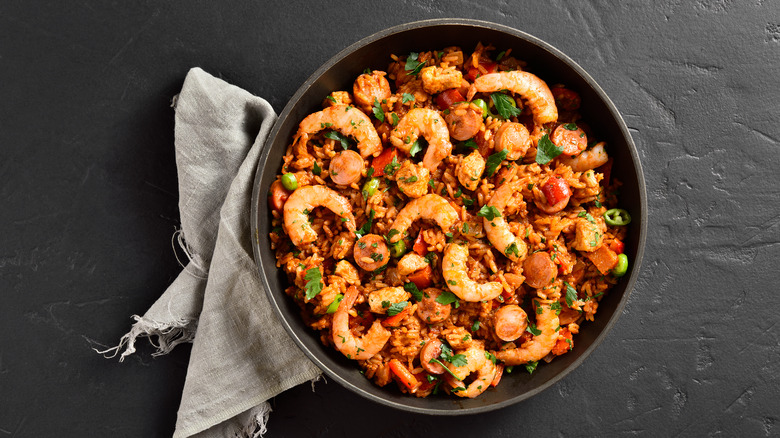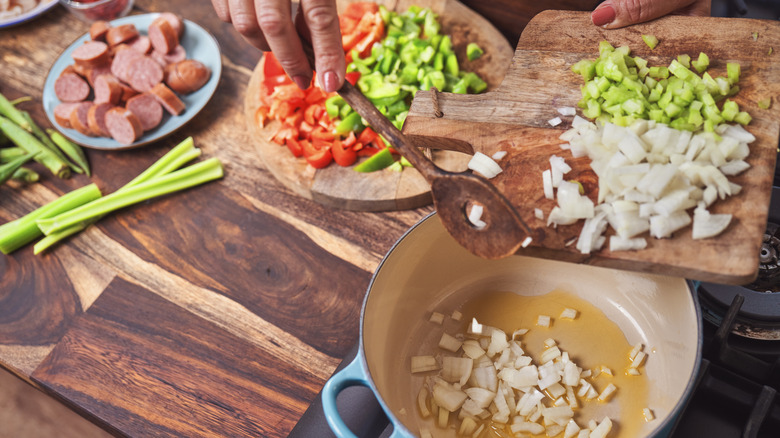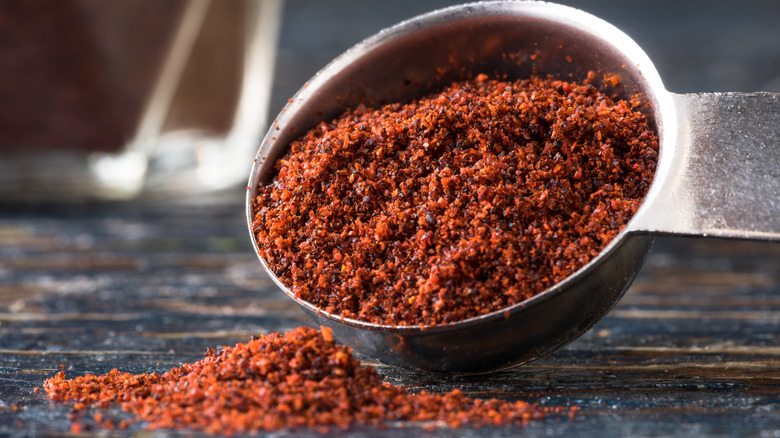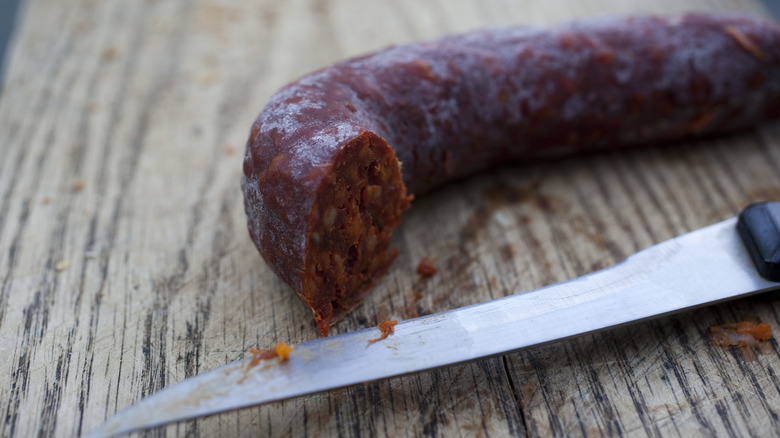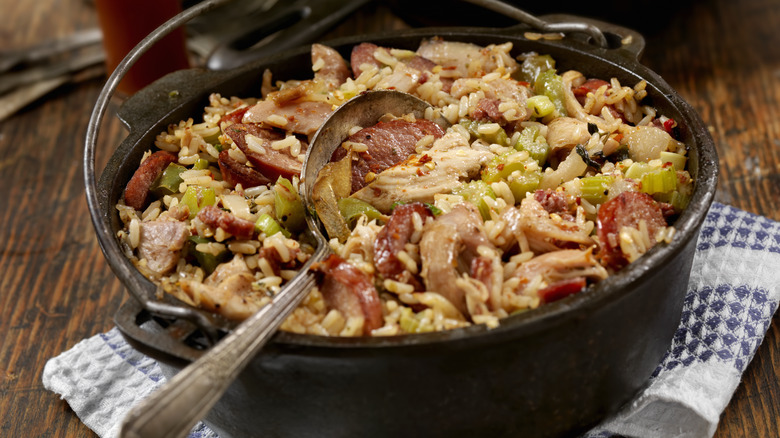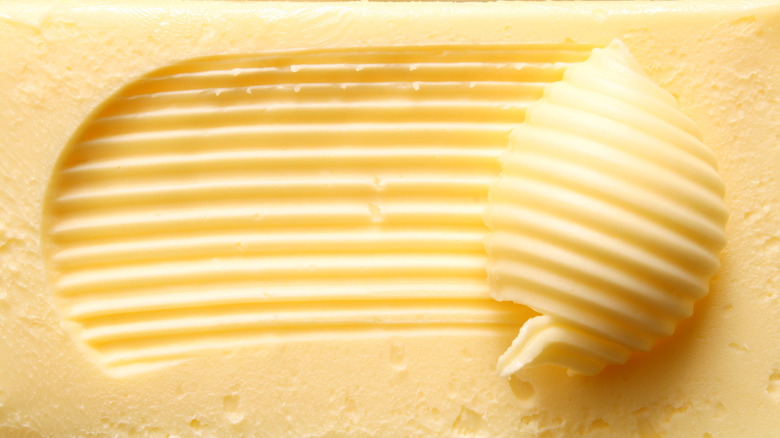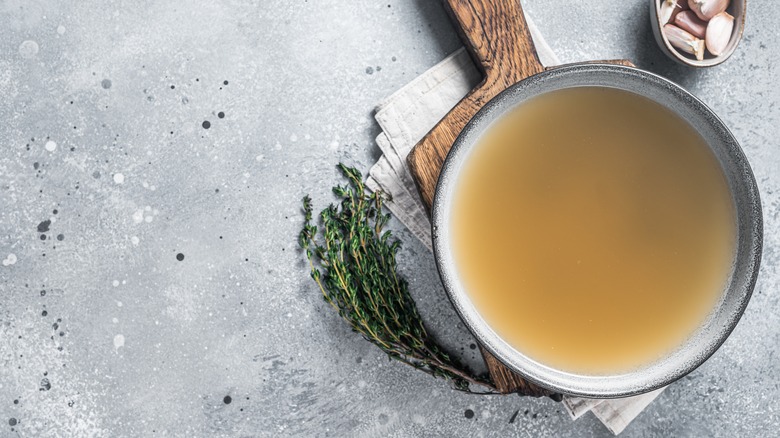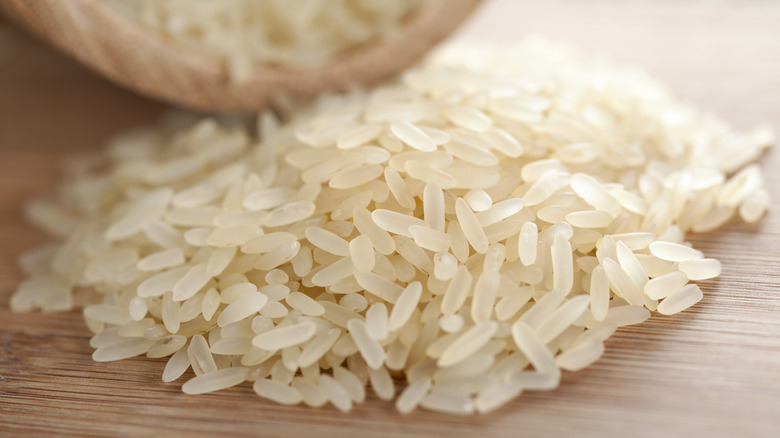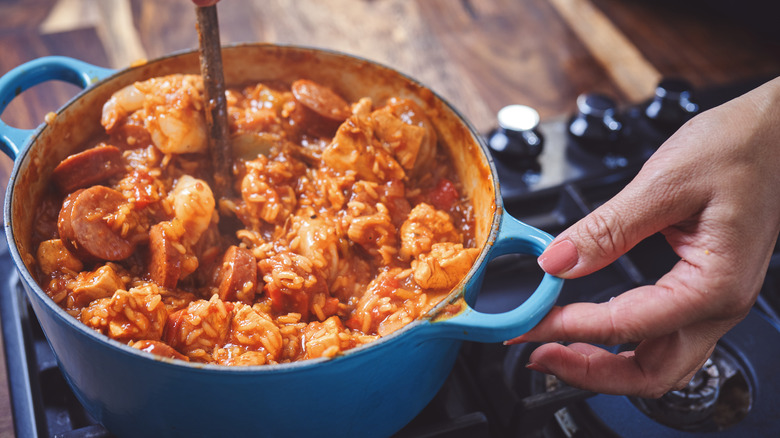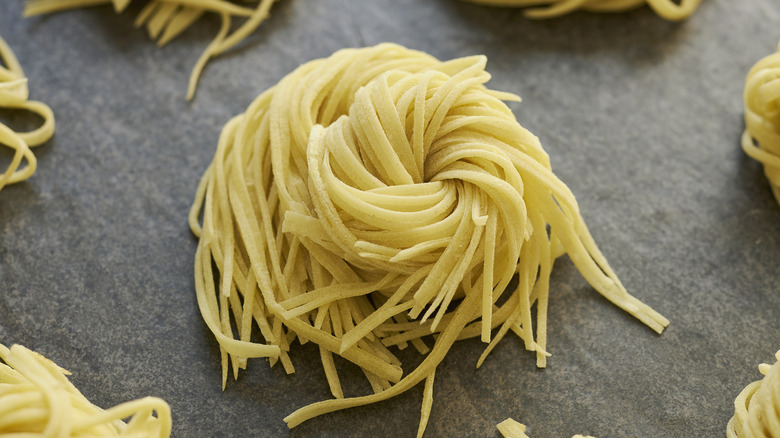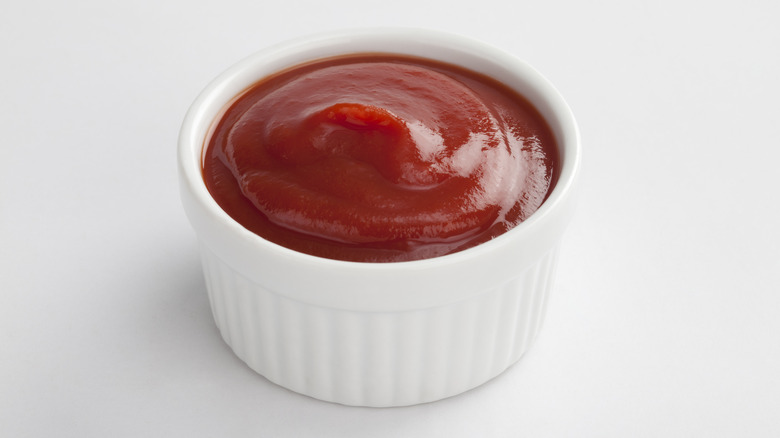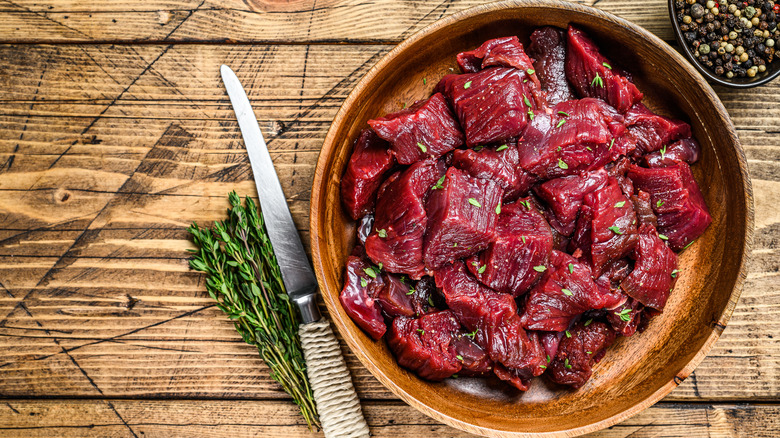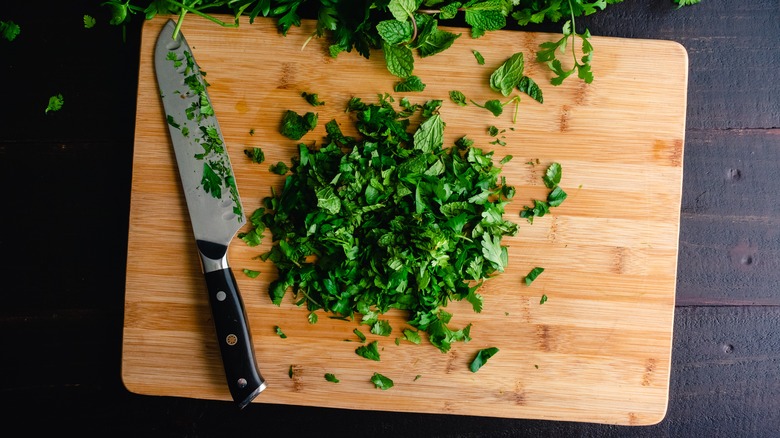14 Ways To Jazz Up Your Jambalaya
Jambalaya is one of those foods that it's virtually impossible not to love. Existing alongside other quintessential Southern dishes like gumbo, jambalaya has its roots in both New Orleans — where the Creole version of the dish originated — and more rural parts of Louisiana, where the Cajun variation was developed. While the two versions of the meal differ slightly, both of them offer up a delicious mixture of rice, meat, and vegetables. When these affordable ingredients are cooked together, they create an easy, one-pot wonder that will feed the whole family.
However, while jambalaya is a reliably delicious dish, it's really easy to fall into the trap of making it the same way every time. Knowing exactly how to prepare a meal, and what it'll taste like, has its comforts. But you might be missing out on some key ways to take your jambalaya to the next level — and some of those ways are super simple. We're here with some tips and tricks about how to jazz up your next jambalaya. Grab your spoon and a bowl, and let's dive in.
1. Experiment with your vegetables
Part of what makes jambalaya so satisfying and nutritious is the mix of vegetables that accompanies the rice and meat in the dish. Gumbo and jambalaya (other Southern staple meals) are created using the delicious trio of onions, celery, and bell peppers. These veggies serve as a flavor base for the rice dish, upon which the proteins, rice, and seasonings are layered.
But why just stop there? While it wouldn't truly be a jambalaya without these three vegetables, adding further ingredients can help to bulk out the meal, and make it more nutritious. For people seeking to make a vegetarian jambalaya, subbing out the meat with eggplant or mushrooms can provide it with some heartiness. Adding in some green vegetables, like broccoli or green beans, can also give it freshness, while again making the meal go even further.
Other vegetable additions (or substitutions) can change the taste of jambalaya to add new, interesting notes. If you're feeling especially adventurous, you can even shake up the trio of onions, celery, and bell peppers a little. You could change up the onions for shallots, to give it a slightly gentler, more aromatic flavor. With this meal, the world is your oyster.
2. Use specific cookware for extra flavor
One of the simplest ways to jazz up your jambalaya starts before you even begin to cook the meal. If you want a better-quality jambalaya, you need the right type of pan. The best material to opt for is black cast iron. Ideally, you'll want a heavy-bottomed pan, the larger the better. Remember, this is a dish that's meant to feed a hungry crowd, so don't try and make your jambalaya in a small vessel.
Cast iron cookware is ideal for making jambalaya, as it holds heat exceptionally well and consistently, and doesn't drop in temperature too quickly, or heat in a spotty fashion. All of these things are just right for jambalaya, specifically the cooking of the rice. As you want every grain of rice to be cooked to perfection, not overdone or underdone, you need the pan to be the same temperature throughout.
To add to this, cast iron cookware is also the best choice for a nice crust at the bottom of the pan. While this isn't necessarily essential for jambalaya, having a layer of slightly crispy rice at the bottom provides an excellent texture contrast. Best of all, though, is that cast iron cookware is built to last — so buy yourself a pot to make jambalaya, and you'll be able to use it again and again.
3. Add a different kind of spice
You might expect jambalaya to be super-spicy, but in fact, it doesn't take a huge amount of seasoning to make it. Generally, jambalaya can be made with little more than salt, pepper, and a few extra things, like garlic or red pepper. This is because the dish gets most of its flavor from other components, like sausage.
But if you really want your jambalaya to stand out, reach for the spice rack. Adding in a different kind of chili or spice can introduce the dish to an entirely new world of flavor. For more heat, a teaspoon of chipotle or cayenne powder will elevate your jambalaya. Cayenne powder will give a subtle kick of spice and intensity, whereas chipotle powder brings a tangy smokiness that will complement the proteins well.
Adding peri-peri chili powder can also provide heat and earthiness. Just bear in mind, though, that if you're using a heavily-spiced sausage, adding in too many additional spices may overpower the dish. Because of this, it's advisable to do a taste-test of any sausage you're using, to make sure you're not going to make your jambalaya taste too intense.
4. Use alternative sausages
Anyone who consistently makes jambalaya knows the importance of the sausage you choose. For jambalaya diehards, there's no other choice but andouille. Andouille is a spiced, smoked sausage that originally comes from France. It's commonly used in Cajun and Creole cuisine, thanks to the French cultural influence on states in the American South.
But andouille is not the only sausage you can use. While some folks might swear by it, the truth is that different spiced sausages can create new and exciting flavors in your jambalaya. One of the easiest swaps you can make is to use chorizo instead of andouille. This classic Spanish sausage is spiced heavily with paprika, giving it an intense flavor and color. When added to jambalaya, these seep into the rice and other ingredients and make everything taste seriously good.
You can also experiment with using hot Italian sausage, which provides both spice and fragrance from its seasonings, or even soppressata, a heavily-flavored Italian salami that has a strong peppery flavor.
5. Opt for the freshest local ingredients
One of our favorite things about jambalaya is you can throw it together with ingredients that you may well have lurking in your cupboard or salad drawer. Chop a few things up, simmer it with some rice, and you've got a fabulous dinner on your hands. However, if you want things to become truly divine on the jambalaya front, it's wise to head to the store beforehand. You'll want to use the best, freshest ingredients you can find, recommends Chris Wadsworth, a chef at Goûter Restaurant in Baton Rouge, Louisiana.
Buying local isn't just sustainable, it also means that the food is getting from farm to table much, much quicker — which inevitably means things taste better. "Once you convert to this lifestyle, nothing else will taste right," Wadsworth told 225 Magazine. Remember, buying fresh doesn't just apply to your vegetables. Your shrimp, chicken, and sausage should all be the best quality you can find, well within their expiry date, and from a reputable source. Trust us, it'll make all the difference to that first mouthful.
6. Experiment with your herbs
Jambalaya is a hearty food, but there are times when that heartiness becomes heaviness. The combination of rice and meat can mean that sometimes, jambalayas tend to feel overly dense and even boring.
When this happens, there are few better ways to liven it up than by adding herbs. Throwing some herbs into a jambalaya gives the dish a zip and freshness that can stop it from feeling too stodgy. The flavors of oregano and thyme work particularly well in Cajun and Creole versions of jambalaya. Common in both cuisines, oregano and thyme have a combination of floral and earthy notes, which means that they pair well with the spicier tastes in jambalaya, while also lifting the rice dish.
As jambalaya is slowly simmered with stock or water until it's cooked, we'd recommend using dry herbs over fresh ones and adding them towards the beginning of the cooking process. Dry herbs have a more intense flavor, which diffuses through the carbohydrates and proteins in the pot. If you want a last-minute pop of brightness, however, you could also stir some fresh herbs through the jambalaya just before you serve it.
7. Mix up your fats
A good amount of fat is essential to any well-made jambalaya. A certain amount of fat is needed to saute the vegetables and proteins before adding the rice and liquids, developing a good browning that adds flavor. But the fat that you choose can make a big difference to your end result. In our opinion, choosing certain fats will make things taste all the better. The standard fat for jambalaya is a neutral oil, but if you want to make things taste more luxurious, try starting things off with butter. The butter will add a velvety richness to everything you're cooking, resulting in a palate-pleasing meal.
If you want to amp things up even more, you can finish off your jambalaya by stirring a pat of butter through the cooked rice, meat, and vegetables. If you don't have any butter to hand, margarine can make a good substitute and will add a little more flavor than standard neutral oil. Whichever fat you're adding, though, remember not to throw in too much. Your sausage will release further fat into the dish as it browns, and some sausage varieties can be super fatty — and the last thing you want to do is to end up with a jambalaya that's greasy.
8. Use stock instead of water
Some jambalaya cooking hacks are so simple that you'll kick yourself for not thinking of them sooner. Using stock instead of water is pretty much the easiest thing you can do for a more flavorful meal. While many jambalaya recipes call for water to cook the rice in, stock adds depth and a kick of umami that pure water just can't replicate.
Chicken stock is the best choice for a jambalaya, thanks to the fact that its flavor profile works well with the sausage and shrimp, as well as (naturally) the chicken in the meal. Vegetable stock also works well and can give the jambalaya a slightly woodier taste. You don't even need to make stock in advance, either. You simply have to crumble your stock cube into the pot just before you add your water and stir it briefly once the liquid's in.
On the other hand, if you want to have a go at creating your own flavorful broth, or you're worried about the sodium content of some store-bought stock cubes, it's easy to make chicken stock on the cheap. Grab any leftover pieces of chicken carcass you have, and put them in a large pot with some chunked-up onions, carrots, celery, and potatoes. Add water and salt to taste, and let it all simmer away for a few hours, before straining the liquid to use in your jambalaya or elsewhere.
9. Choose a high quality rice
Jambalaya is a pleasing mix of many different ingredients. But the one that holds it all together — and is the most abundant when it's all cooked — is the rice. Given that rice will comprise the eventual majority of your meal, picking a high-quality grain is arguably one of the most worthwhile things you can do.
The first things you should be looking for are color and texture. For white rice, the grains should look vibrant and healthy, not dull or yellow. They should also feel hard. They should not feel chalky, brittle, or sticky, all of which can indicate an older or deteriorated product. It's best to use long-grain rice in jambalaya, as they don't tend to stick together as much as short or medium-grains do. This will keep your dish light and not gummy.
Regular long-grain rice will do the trick, but basmati and jasmine rice will also produce a good result. If you wish, you can use brown rice in your jambalaya, but bear in mind that not only is this not the authentic choice, but it will also take longer to cook and will be chewier and less fluffy than white rice.
10. Make sure you nail your cooking stages
On the surface of things, making jambalaya feels as simple as throwing everything in a pot and leaving it to cook. If you so wish, you can make your jambalaya that way — but you'll also miss out on extra flavors and textures. Instead, the best jambalayas extract the most flavor from each element, by cooking every component of the dish in stages. "The beauty of jambalaya is that it pulls flavors from many ingredients to create the perfect one-pot meal," Manda Fine Meats chef Patrick Yarborough told 225 Magazine. "It's all about building flavor through each cooking step and getting all the flavor you possibly can out of each ingredient."
When cooking jambalaya, focus on one thing at a time. Begin by browning your meat separately, then your vegetables. Use the fat from the sausage and those awesome browned bits to flavor the vegetables, and avoid cleaning your pan between stages — as you'll get rid of some premium flavor. Once you add everything back in, add your spices, and finally your rice and cooking liquid. Trust us, the flavor layers will be out of this world.
11. Use something other than rice for a special jambalaya
For a lot of people, the main selling point of jambalaya is the grains of fluffy, comforting rice that envelop all the other ingredients. But those people clearly haven't tried jambalaya pasta. Using an alternative carbohydrate in jambalaya is one of our favorite ways to elevate the dish. Purists may argue that doing so stops it from being jambalaya in the first place, but it's a great way to serve something different and spice things up without adding additional seasonings.
Jambalaya pasta, made popular by The Cheesecake Factory, dispenses with the rice-simmering stage of the dish. Instead, all you need to do is saute your chicken, sausage, shrimp, and vegetables, add your seasonings, and cook until everything's done, before stirring some pasta through. You can use either white or whole-wheat pasta — going for the latter will give your jambalaya pasta a bit of a nuttier taste. You could also swap out rice for beans in jambalaya. Again, while this would stop it from strictly being jambalaya, it would also add some additional protein and fiber to the meal.
12. A squirt of ketchup can make all the difference
You've made your jambalaya, and it's almost ready to serve. Then you give it a taste, and somehow, it feels a little flat. You followed the recipe by the letter and added enough salt and seasonings, but it's still not entirely singing as it should. What do you do?
In this situation, the best ingredient to add to save your jambalaya last minute is likely already sitting in your pantry. A squirt of tomato ketchup can give your food a burst of flavor that works perfectly with the taste of the rice dish. Tomato ketchup has acidity and sweetness that immediately brightens any tomato-based meal, and can add an extra layer of flavor that lets the jambalaya activate every taste bud on your tongue.
In a pinch, tomato ketchup can also be one of the best substitutes to use in place of tomato paste, if your jambalaya recipe calls for it. Just remember that some tomato ketchup brands do use a fair amount of sugar and sodium in their recipes, so make sure you're reducing any added salt and sugar elsewhere.
13. Experiment with different proteins
Anyone familiar with jambalaya will likely be familiar with the key proteins of chicken, sausage, and shrimp. This trio of meat and seafood shows up time and time again in jambalaya recipes. But if you're in the mood to switch things up, you might want to start with the proteins you're using. The meat and seafood added into jambalaya can change depending on the region it's being made in. Each change brings new flavors.
Swapping out the chicken for turkey or duck can give your jambalaya a slightly gamier flavor, especially if you're using darker cuts of meat. If you want things to taste even meatier, you could also sub in pieces of venison or boar meat. Using venison or beef sausage in place of the classic andouille is another way to do this — although keep aware of the fact that doing this will also remove some of the specific spicy tastes that make jambalaya so special.
On the seafood side, making jambalaya with mussels, oysters, or clams instead of shrimp will add briny flavors, and may make it lean a little more towards a seafood paella. For the super-adventurous out there, you can even add in alligator meat.
14. Adding a garnish will improve things
Once your jambalaya is fully cooked and ready to serve, all you have to do is spoon it into a bowl, find your spoon, and get ready for food heaven. But before you do that, one final touch will make all the difference. A garnish of chopped herbs is an addition that adds ways more than you think. Garnishing food adds not only extra color and makes things look pretty, but it also provides extra textural interest and fresh flavors to the meal.
More importantly, garnishing food may have a psychological effect that makes your dinner taste even better. A scientific study published in the journal Appetite examined the impact of food presentation on how we perceive a meal to taste. It found that when two identically-made dishes were served in different ways — with one of them being more aesthetically pleasing — the more attractive dish was deemed to taste better overall. It appears that the better our food looks, the more we'll enjoy it. An easy sprinkle of chopped parsley or chives, which both work well with jambalaya flavor-wise, will have your friends and family singing your praises.
